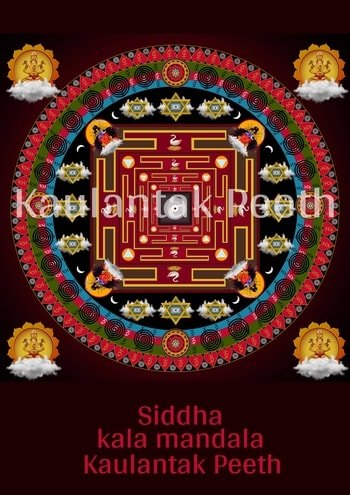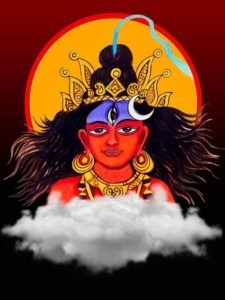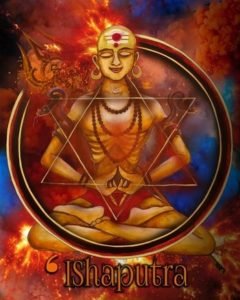Kāla means time, and Manḍala means group. Time as we experience, its a divine consciousness. Siddha Dharma reveals a devata who controls and manages time. This devata is an invisible devata. He is formless. There is another divinity of time known as lord of death, Yamaraja who is also a manifestation of Shiva but he is not the actual devata who we refer to as Kaala or time. This invisible god of time has never manifested in front of any person. The very idea of “time” (who is formless God of time) manifesting in time is not possible. God of time does not have a physical form that can be manifested.
Philosophy of Desha, Kāla & Paristhiti
As per “Siddha Dharma”, Time also has a beginning and an end. We too are tied to this time. We also live our life in harmony with this time. Now, in Kaulantak Peeth, three things are very important in all spheres. They are called Udgosha or proclamations of Kaulantak Peeth. They are “Desha, Kāla and Paristhiti”. This implies time, place and circumstances. Time as Kāla, Desha as area or location or physical place and Paristhiti meaning circumstances. All things are dependent on the. Desh doesnt simply imply earth but water, sky, gases, light, darkness any given place. It could even be different planet and different universe. It could be any area. Kāla is time, and circumstances implies the condition in which one exists. Together with all these three, one develops the idea of experience which is actually the experience of Māyā.
Circumstances that you find yourself in, your situation, your body condition, your senses define your circumstances. The way your senses and perception are, you similarly understand time and place in its subjectivity through relativity. No beings have the same circumstances in the whole universe. So, their experience of time and capacity to understand time must be different as well. So, there is an idea of time based on this subjective experience of time-based on one’s unique circumstances. One must understand this properly. Is time then only subjective experience based on circumstances? Or is there a flow of time independent of all? One doubts if time is a mind construct which implies the same idea of time being dependent on circumstances.
Importance of Kāla Manḍala Sadhana
Kāla Manḍala sadhana has a two-fold purpose. First to make you understand the finer aspect of nature of time and then how you can establish yourself in harmony with the nature. This is done through understanding the philosophy of desh, kāla & paristhiti.
As per “Siddha Dharma”, Kāla Manḍala is defined as various times within one same mandala. Kāla Manḍala means that there are many forms of time in this universe each operating in its own motion and pace. Each place, corner of the universe has its own time. Time is different and not constant in different parts of the universe. Talking about the earth, even it doesn’t have one constant time. There is always a time difference fast or slow between places. Even two mountains of the earth don’t have the same time. The Alps of Europe and Himalaya doesn’t have the same time even though both being mountains.
Etymology
As per “Siddha Dharma”, Kāla Manḍala is made up of two words, Kāla means Time and Mandala means group with the same locus. In yantra, the lotus petals are made around the bindu (locus point). All the petals surround the middle point of the flower. The midpoint is the bindu while petals are the mandala. So, similarly MahaKāla is the bindu and all other Kāla is its mandala.
From above, we can infer that Kāla Manḍala means different forms of time that is prevalent in this universe which circles around the same locus point called MahaKaala.
Origin of Kāla Manḍala
As per “Siddha Dharma”, Lord Shiva had just opened his eyes after a long samadhi. When he opened his eyes, he saw Shakti. Since, Shakti had waited a very long time for lord Shiva’s samadhi to break, he was pleased with Shakti. He then told Shakti that he would be imparting her the diksha of Kāla and asked Devi for a moment so that he could close his eyes and in the provess initiate her to the various Kāla in this universe. He then close his eyes for a samadhi
After lord Shiva had closed his eyes, the face of Shakti changed as she was tensed because lord Shiva when he goes to Samadhi, he only opens his eye after long time period. Shakti had already waited long for him to open his eyes. No sooner had lord Shiva closed his eyes, Shakti was thrilled to see him opening his eyes the very next second. It was like a slow blinking of his eyes. She was relieved and asked Shiva that whenever he closes his eyes, he goes to a deep samadhi but this time, he just blinked and what was the reason behind it?
As per “Siddha Dharma”, lord Shiva then replied to Parvati that he indeed had ascended to the state of samadhi. Shakti shocked asked him as to how it was possible because she along with mortal beings blank their eyes all the time yet they never reached samadhi. She also further asked whether if it was possible for any sentient beings to have the experience of samadhi for such minute time period of an eye blink? The rationale behind the question was that she had already heard multiple times from lord Shiva that one loses all account of time in the state of samadhi.
Lord Shiva then replied to Ma Shakti that it was possible for all to experience the state of samadhi even if it be for a eye blink. He further continued that it was only possible because of Kāla Manḍala because time is not constant everywhere in this universe. Time varies with places and universe. He further told her that when he blinked his eyes, he had connected himself to Kāla Manḍala and he had gone to a deep long samadhi period but she only saw him blinking his eyes because the time was different from his samadhi to the usual time at Kailash.
Lord Shiva further explained that in their moment he had already experienced a deep samadhi but for Shakti it was just an eye blink. Lord Shiva then explained Shakti that such phenomenon can only happen when one is the master of Kāla Manḍala and he then initiated Shakti into Kaala Manadala.
Kāla Manḍala Yantra
As per “Siddha Dharma”, Kāla Manḍala yantra is uttara āmanāya yantra. It is drawn and understood from inside out. In the center there is a black dot. Surrounding it is six concentric circles. On the outer most circle there are sixty four pushpa petals in the shape of betel leaves. Enclosing the circles are four squares. Then four bhupura each in a box. So four bhupura in four boxes, each one enclosing the previous one. Then there are four more circles made with thicker lines.
This is considered a very sacred and mystical geometry. Each part of this geometry is very significant and contains deep secrets. Each portion is ripe with many symbolism. In itself, it is a samaya chakra which encapsulates the “desh, kāla & paristhiti” philosophy. It is sort of a map of the universe. It can be only learnt from a siddha guru through the eternal guru disciple tradition. There are many divinities associated with this yantra. There are six dharma chakra of kurukulla on the outer circle. Dharma chakra is the chakra that sprouts the kalā, artforms of devi in the universe and makes the universe a manifestation of beauty. This chakra gives rise to satvik, rajasic and tamasic guṇa and three hidden guṇa. All six guṇa, three known and three unknown constitute the universe.
Kāla Manḍala Sadhana, Kāla and MahaKāla
As per ““Siddha Dharma”, Kāla means time and MahaKāla means beyond time. It is from MahaKāla time starts and time dissolves. Since, MahaKāla is the point where all Kāla revolves in a circle, MahaKāla has the power to destroy any Kāla and also to create it.
The “Siddha Dharma” mentions that MahaKāla is beyond everything. It is beyond matter, energy, time etc. It is represented by pure darkness because it is infinite and devoid of any gunas or attributes. It is his consort or shakti Mahakaali, who plays an active part in managing time.
As per “Siddha Dharma”, there are thousand faces of Kāla in this universe that means there are thousand types of time in this universe which is in their motion. Every Kāla is different from another. For instance, the day and night of Brahma is considered to be two kalpas of this planet earth. When Brahma spends his day and night, there is so much transformation in the earth that it under goes two great destructions, twenty-eight manvantara and any many yugas. The Kāla of Brahma ji and this planet earth is simply incomparable but both are within the domain of Mahakaala.
Kaala, MahaKāla and Kundalini
The “Siddha Dharma” also mentions that Mahakala has all together thousand faces. And those thousand faces are Kāla of different time and period. This can be well understood through the analogy of a human body and kundalini.
As per “Siddha Dharma”, in the human body there is sahastrahar dal chakra which is portrayed as thousand petal lotus. The thousand petal lotus surrounds the Shiva bindu. The Shiva bindu is the bindu of MahaKāla because Shiva bindu is beyond time, matter, gunas etc. The thousand petal lotus are thousand faces of Kala inside us or every lotus petal in us represents a particular Kaala.
When the Kundalini Shakti reaches the crown chakra then the yogi becomes Shiva himself or Mahakaala. He is not bounded by inner time therefore he is free from this loka and this universe. He can then travel from one planet to another in no seconds and achieve impossible feats related to time.
Swachchhanda Bhairava & Kalā Manḍala
As per “Siddha Dharma”, Swachchhanda Bhairav is the lord of Kalā Manḍala. Without the sadhana of Swachchhanda Bhairava, one cannot accomplish the sadhana of Kalā Manḍala. Kalā Manḍala sadhana begins with practices of the manifested form of Swachchhanda Bhairava and then proceeds to the formless aspect of Swachchhanda Bhairav. Only after accomplishing this prerequisite, one enters the crux of the practices in Kalā Manḍala Sadhana.
Mahasiddha Ishaputra and Kāla Manḍala
As per the legends of Kaulantak Peeth, Mahasiddha Ishaputra had attained the state of samadhi four times in his life. The first samadhi span was nearly a fortnight, the second samadhi span was twenty-one days, the third samadhi span was three months while the final samadhi was of ten days only.
Because of his first two experiences, the guru of His Holiness, Mahasiddha Siddhant Nath conferred him the title of “Mahayogi”. His guru didn’t confer him the title in his first experience because the first time can always be a fluke. When he reached the state of samadhi second time, his guru was still sceptic of samadhi experiences because His Holiness could simply perform sadhana in any particular asana or in sadhana without any movement for months.
When His Holiness had the experience of third samadhi and it was in the span of three months, Mahasiddha Siddhant Nath then recognized all his samadhi experiences and wanted His Holiness to not pursue samadhi further because if Mahasiddha Ishaputra hits samadhi the fourth time, it would be a “Mahasamadhi” and from that state nobody has ever descended down. It is virtually impossible for a person to reach the state of “Mahasamadhi” and then make a return to this world. Nobody has ever reached that state and came back.
As per “Siddha Dharma”, the guru of His Holiness Mahasiddha Siddhant Nath then initiated him into “Kāla Manḍala” diksha because he didn’t want His Holiness to reach the state of “Mahasamadhi” accidentally while performing other sadhanas. His Holiness got initiated and was ordered by the great guru to practice the sadhana for a year. His Holiness then started chanting the mantra and elongated his sadhana to one and half years.
After the conclusion of the sadhana, His Holiness then meditated and attained the state of samadhi for the span of ten days. His Holiness reiterates that the fourth samadhi which was only ten days was the most productive samadhi among all other even if had the least time span. His Holiness because of the perfection of Kāla Manḍala sadhana, he had hit samadhi for ten days but in another Kaala, he had attained samadhi for a very long time. Ten days of His Holiness samadhi was equal to millennium span of samadhi in another Kāla and his experiences widened because he had enough experience of samadhi.
Mahā Sidddha Ishaputra As Kalādhipati of Siddhas In Kaulantak Peeth
As per “Siddha Dharma”, with his accomplishments in Kalā Manḍala Sadhana, Mahā Siddha Ishaputra has obtained great realization. Since he is the head of Kaulantak Peeth, he is revered as Kalādhipati of Siddhas in Kaulantak Peeth.
Some examples of Kāla Manḍala
As per “Siddha Dharma”, the scriptures are jam packed with examples of Kāla Manḍala. The most prominent is Devarshi Narada or Mahasiddha Narada Nath. He learnt Kāla Manḍala sadhana from lord Vishnu and because of the perfection of Kāla Manḍala, he could travel many places in seconds.
There are many such examples of use of Kāla Manḍala in the scriptures. The two examples of Kāla Manḍala are related to lord Krishna himself. He was the master of Kāla Manḍala sadhana and he learnt it through his guru Mahasiddha Sandipini Nath. There are two incidents in lord Shree Krishna’s life,
Vasudeva escaping the prison at night
As per “Siddha Dharma”, when Kamsa was predicted to be killed by his own sister’s son, he imprisoned his sister Devaki and her husband or his brother-in-law Vashudeva in the prison so that he could kill all the children of Devaki and Vashudeva. Every time, Devaki would give birth to a baby, Kamsa would snatch the baby and kill it. This continued till the seventh child. When lord Krishna was born as the eight child and in the night time, the scriptures says that every locks unlocked itself, all the guards had slept and Vashudeva managed to escape the prison, walk from Mathura to Vrindavan which is many miles away, exchange lord Krishna with the daughter of Yashodha and return back and be unnoticed.
The story is finest example of Kāla Manḍala as Vashudeva was put into another Kāla by the influence of Yogmaya and all the guards were in their normal Kaala. In the blink of the eye of the guards, Vashudeva had managed to exchange Krishna with Yashoda’s daughter and return back to his prison. This was all possible through Kāla Manḍala because of the influence of Kaala.
The whole incident of Bhagawad Geeta
As per “Siddha Dharma”, the whole incident of Bhagawad Geeta was also performed under the influence of Kāla Manḍala. The scriptures mention that the time had halted when lord Krishna gave the wisdom of Geeta to Arjuna and when the eighteen chapters of wisdoms ended then time again back to its real state.
As per “Siddha Dharma”, the time didn’t halt at the time of the incident of Geeta. It was the same time for both Pandavas and Kauravas but lord Krishna with the mystical power of Kāla Manḍala took Arjuna to another Kāla and imparted him the wisdom of Geeta. He even managed to give Arjuna the divine glimpse of his “virat rupa”. For Kauravas and Pandavas it was just a blink of an eye but for Arjuna and lord Krishna it was the the most unprecedented work in the history of any avatara’s life.
Kāla Manḍala tradition and lineage
As per “Siddha Dharma”, the lineage of Kāla Manḍala starts from lord Shiva. He first initiated Shakti as discussed above. When he had initiated Shakti, lord Vishnu came to know about the initiation so he brought his consort Lakshmi, Brahma ji and his consort Saraswati with him. Lord Shiva also initiated all of them to the Kāla Manḍala sadhana.
As per “Siddha Dharma”, Devarshi Narada Nath learnt this wisdom from lord Vishnu. Brahma ji initiated his manas putra into this wisdom and later Sapta Rishi received this wisdom. The Sapta Rishi did not receive this wisdom with lord Vishnu and Brahma but later. The wisdom was passed on to Daitya Guru Sukracharya, Dev Guru Brihaspati and from them, it reached Kaulantak Peeth and then the eighty-four siddhas received the wisdom.
As per “Siddha Dharma”, the main proponent of this Vidhya is Mahasiddha Bhringi Khechara Nath Ji. He is believed to be a Shivagana too and he played a very instrumental role in simplifying the Kala Mandala sadhana to the Siddhas of Kaulantak Peeth.
The modern-day revival of this sadhana can be credited to Mahasiddha Matsyendra Nath ji as he directly heard the conversation between Shiva and Shakti, decoded it and infused it into his own tradition and lineage, the “Kaula Siddha” lineage. In fact, he revived many lost wisdoms.
His Holiness Ishaputra received this wisdom from his Mahasiddha guru, Mahasiddh Siddhant Nath.
Literature
Kāla Manḍala Kalpa (is being written)



